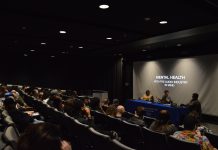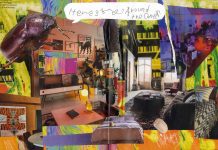Webster student Taylor Zarr began thrifting and upcycling clothes out of her love for sustainability. She said her main motivation, even when sharing her creations, is not about making money. Gabriel Peppers, another Webster student who started the clothing brand “Dayzed,” felt the same way.
For both students, creating and designing clothing is a way to connect with and inspire others.
Driving motivation
Zarr is a philosophy major with an emphasis in arts and creativity. In one of her courses, Zarr said the class discussed the idea of whether art can have a practical use. She thought it could and she used clothing as an example.
“Everyone’s wearing some sort of piece of clothing,” Zarr said. “We use it as a form of expression, whether it’s plain monotone clothing or something crazy and extravagant.”
Peppers’ clothing brand, along with his graphic novel called “Topia Ending Days,” are expressions of the subconscious mind. He also focuses on peoples’ thoughts and feelings.
For the clothing brand, Peppers said he was particularly struck by seeing posts on social media where people expressed their feelings. He said seeing people also express their feelings and thoughts on social media inspired him to put designs on black backgrounds, as he was trying to reflect the look of social media posts. Overall, Peppers said he wanted to create a personal brand.
“Think about any movie animation, cartoon or hit songs. Those are the best when they target and when you can relate to them,” Peppers said. “Anything has to be relatable in order for it to be very good and true. And it’s all naturally going to be good because that audience can relate to it.”
Webster student Austin Davis has been a model for some of Peppers’ designs. Davis is an animation major and has not been involved in modeling before. However, he said he wanted to be involved because he felt Peppers created a brand people could relate to.
“He has one that talks about how the days have been since COVID Zoom, repeat, eat because everyone’s been doing that,” Davis said. “It’s something that I can relate to – everyone can relate to – and everyone is able to just probably connect better because we all have been through the same experiences.”
For Zarr, thrifting and upcycling clothes came from her desire to avoid “fast fashion.” Michael Brady is a philosophy professor who teaches environmental ethics at Webster University.
He said clothing relating tasks like production and transport contribute to about 10% of global carbon emissions. That percent is mirrored in a 2018 press release from the United Nations Economic Commission for Europe, which also estimated the fashion industry is responsible for 20% of wastewater.
“There’s just a whole lot of messed up things with the fast fashion industry,” Zarr said. “So to remove myself from that as much as I can, and then also support the other side of it and use the clothes that are already here on this Earth to create less waste and new items is the whole part of it.”
Along with sustainability, Zarr said she also wants to share her creations with others and inspire them.
Brady said in order to overcome the negative environmental impacts of “fast fashion” it is important for people to educate themselves, learn and make individual decisions to change their habits. Changing habits and behaviors, however, can take time.
Brady said coming together in groups to stand up against the current system can have even more of an impact.
“If you and I can get a bunch of people to not do that,” Brady said, “to think about the habit or learn about the habits through an article or a class, or just talking to your friends or whatever, it can start to create like groups of people and then groups are powerful.”
Getting Started
Zarr said she has upcycled and created clothing for others as gifts, and said she considered expanding and making clothes for even more people. Initially, however, Zarr said she was unsure of whether anyone would be interested in her clothing.
Her cousin, who also helped her get a sewing machine to work with, encouraged her to pursue her idea.
“So that really gave me that confidence that, yeah, I have this great idea,” Zarr said.
Dayzed was not the first time Peppers had an idea to start a clothing brand. He said he tried creating a brand called “24/7 Drip” in the summer of 2018. While Peppers put his art on clothes for both brands, he said his initial brand lacked a deeper message.
However, Peppers was grateful for what he has learned from past ideas. He said he felt like learning through trial and error has helped him to grow and adapt his creations.
“I feel like I wouldn’t even have this idea that I have now, if I wouldn’t have done my previous clothing line years back,” Peppers said, “because like, we are where we are today because of something that we did.”
Peppers said when COVID-19 started, it gave him the extra motivation to create a brand once more.
Moving Forward
Dayzed only launched a couple of weeks ago, according to Peppers. However, Davis said he has already received a positive comment when he wore one of Peppers’ designs in public.
“I was at a JOANN Fabrics with my girlfriend wearing [Peppers’] hoodie,” Davis said. “And she loved it. She said, ‘I love that hoodie.’ And I gave her [Peppers’] Instagram and said, ‘Hey, you should go cop one.’”
Zarr has not sold any of her upcycled creations yet. She said she is still figuring out how to distance herself from “fast fashion” while also keeping her creations accessible. She said she is considering a bidding or donation-like sales structure.
Moving forward, Peppers is also considering the future of his brand and graphic novel. He said he is hoping to find opportunities to collaborate and connect with other artists.
“We’re all going to come up by supporting each other,” Peppers said. “No one’s going to come up by themselves.”
Brady said support and coming together as groups are also important for standing up to “fast fashion’s” negative environmental impact. He thought students’ creating clothing – especially when it relates to upcycling and reusing old materials – is amazing. Brady said he would suggest students who are involved in upcycling and sustainable clothing practices work to grow their network.
“There’s so much power in a group and so little power with an individual,” Brady said. “That’s the only real advice I would give is we’ve got to work together. We have to work together or this thing will never get fixed, but if we do work together, our power is really, really, really quite a thing. And it can definitely change these [fast fashion] companies.”
Recently, Zarr said she has had to prioritize other aspects of her life. However, she is hoping to get back to upcycling and sharing her work with others soon. She is currently working to figure out the level of interest people may have in her clothing creations and how to go about pricing.
Zarr offered words of encouragement she learned after speaking with her cousin.
“Don’t doubt yourself,” Zarr said. “Just do it and try it, and even if you do fail or if it doesn’t work like so what at least you did it or at least attempted it or helped somebody else or inspired somebody else.”
Share this post
Cas Waigand (she/her) was the editor-in-chief for the Journal (Spring 2021). She majored in journalism with a minor in photography. Cas also covered COVID-19 and the 2020 general election. She enjoys writing, watching Netflix, crocheting, and taking photos.




